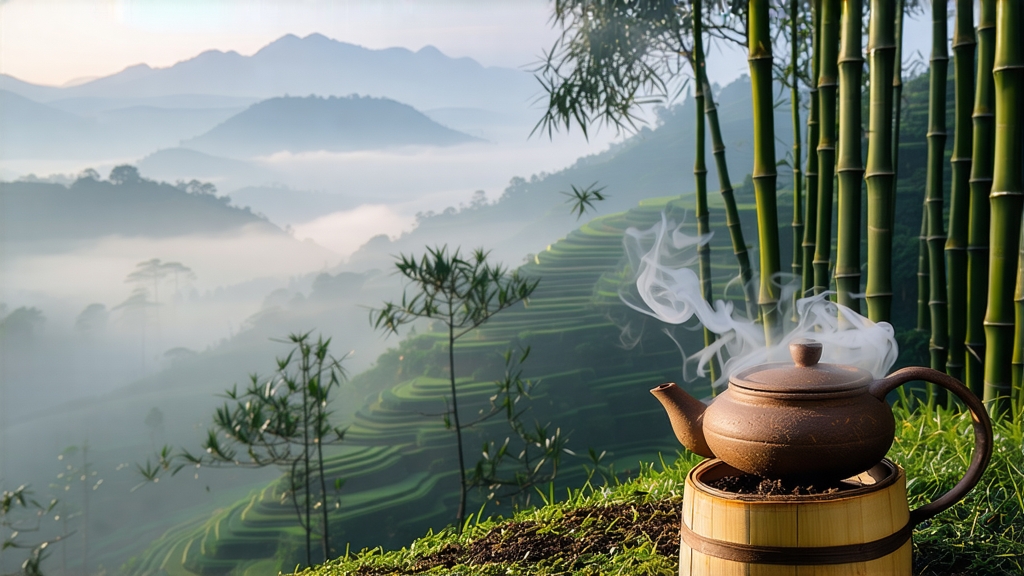
When most people outside China hear “black tea,” they picture a dark, malty cup from Assam or Ceylon; few realize that the very word “black tea” is a translation of the Chinese hong cha, and that the first hong cha ever created was Lapsang Souchong. Grown in the granite gorges of the Wuyi Mountains in Fujian province, this tea was the catalyst that turned a nation of green-tea drinkers into exporters whose leaves would sail around the globe, fill London’s docks, and spark the Boston Tea Party. Yet within China itself, Lapsang Souchong remains a guarded secret, a tea whose smoky perfume evokes both frontier trading posts and imperial courts. To understand it is to taste the hinge on which the history of world tea pivots.
Origin & Myth
Local legend dates the birth of Lapsang Souchong to 1568, late in the Ming Dynasty, when a passing army camped in Tongmu Village and delayed the tea harvest. To hasten drying, farmers spread the leaves over pine fires; the resulting liquor was unexpectedly deep, sweet, and laced with resinous aroma. Whether myth or marketing, the story underscores two truths: the tea emerged from contingency, and its defining character—smoke—was originally a preservative, not a gimmick. By the early 1600s, Dutch traders were carrying “bohea” (the Fujianese pronunciation of Wuyi) to Europe, where it fetched prices higher than silver and earned the nickname “souchong” from the Dutch for “small sort,” referring to the larger, coarser fifth leaf down the stem that was otherwise discarded in green-tea production.
Terroir: Why Wuyi Tastes like Stone and Mist
The Wuyi range is a UNESCO World Heritage site whose cliffs trap clouds the way amphitheaters trap sound. Diurnal swings of 15 °C, 80 % humidity, and mineral-rich, weathered granite force the tea bush to grow slowly, thickening cell walls and concentrating polyphenols. In Tongmu, the only village legally allowed to sell true Lapsang Souchong, elevation hovers between 600 m and 1,200 m; here, the cultivar Xiaozhong (small leaf) has adapted so tightly to local microbes that attempts to transplant it to neighboring counties lose the signature “yan yun” or rock rhyme within two generations.
From Leaf to Log Fire: Two Styles of Craft
Modern Lapsang exists in two parallel universes: the traditional pine-smoked and the contemporary unsmoked “Zheng Shan Xiao Zhong.” Both start identically: buds plus two leaves are plucked in late April, withered on bamboo racks over soft charcoal embers for 8–10 hours until 65 % moisture remains. Rolling follows, 70 minutes of machine-assisted kneading that ruptures 80 % of leaf cells without breaking the surface, initiating enzymatic oxidation. The rolled leaves are then placed 8 cm deep in wooden troughs inside a smokehouse whose floor is covered with three-year-old Masson pine and a pinch of camphor wood. For traditional Lapsang, the smoke phase lasts 18–24 hours at 30 °C; resin condenses on the leaf, bonding guaiacol and syringol to theaflavins and creating the unmistakable scent of smoked apricot. In contrast, Zheng Shan Xiao Zhong bypasses smoke; instead, the oxidized leaf is baked at 85 °C in bamboo baskets lined with cotton paper, yielding a honeyed, longan-fruit liquor beloved in Shanghai and Tokyo. Both styles are finished with a “foot fire” charcoal bake that reduces moisture to 3 %, stabilizing the tea for decades of aging.
Grades & Nomenclature
Within Tongmu, four grades are recognized by the local tea association:
- Special Needle: only buds, smoked for 6 hours, liquor like caramelized Riesling.
- Aromatic Leaf: bud plus first leaf, 12-hour smoke, balance of pine and muscatel.
- Classic Souchong: second and third leaves, 18-hour smoke, breakfast-body.
- Tarry Souchong: fourth and fifth leaves, 30-hour smoke, intense phenolics for Russian samovars.
Anything labeled “Lapsang” but produced outside Tongmu is legally termed “Waishan” (outside mountain